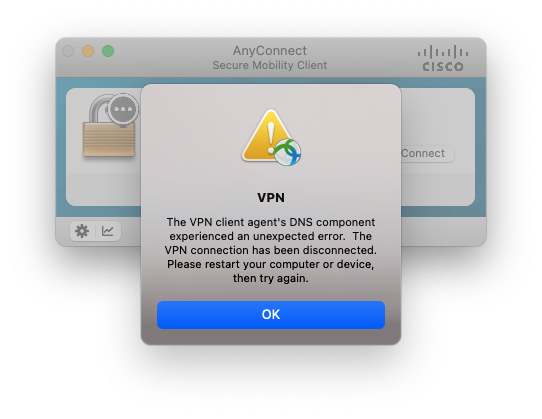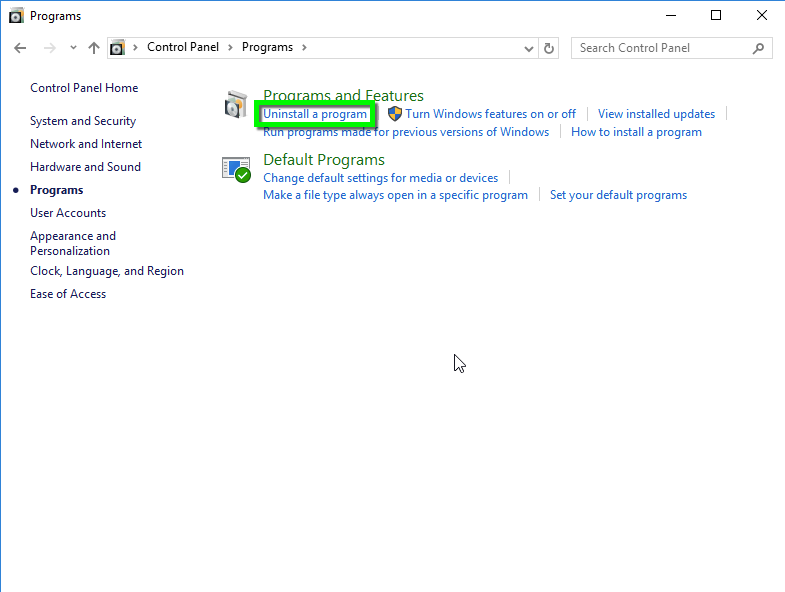Cisco Anyconnect Secure Mobility Client Mac Os
Cisco AnyConnect is the recommended VPN client for Mac. The built-in VPN client for Mac is another option but is more likely to suffer from disconnects.
Overview
Stanford's VPN allows you to connect to Stanford's network as if you were on campus, making access to restricted services possible. To connect to the VPN from your Mac you need to install the Cisco AnyConnect VPN client.
Two types of VPN are available:
A vulnerability in the uninstaller component of Cisco AnyConnect Secure Mobility Client for Mac OS could allow an authenticated, local attacker to corrupt the content of any file in the filesystem. The vulnerability is due to the incorrect handling of directory paths. Apr 16, 2020 After you have logged in, click AnyConnect on the left. In the middle of the screen, click Start AnyConnect. On the Download & Install screen, click Download for Mac OS. Install AnyConnect VPN Client. Search for the downloaded file on your computer and double-click it. An Install AnyConnect Secure Mobility Client pop-up window will open.
- Default Stanford (split-tunnel). When using Stanford's VPN from home, we generally recommend using the Default Stanford split-tunnel VPN. This routes and encrypts all traffic going to Stanford sites and systems through the Stanford network as if you were on campus. All non-Stanford traffic proceeds to its destination directly.
- Full Traffic (non-split-tunnel). This encrypts all internet traffic from your computer but may inadvertently block you from using resources on your local network, such as a networked printer at home. If you are traveling or using wi-fi in an untrusted location like a coffee shop or hotel, you may wish to encrypt all of your internet traffic through the Full Traffic non-split-tunnel VPN to provide an additional layer of security.
You can select the type of VPN you want to use each time you connect.
The Cisco AnyConnect Secure Mobility Client provides also a web-based and cloud-based security option. Downloads of any Secure Mobility Client for Mac uses TLS and DTLS in order for the efficient VPN tunneling to be supported. For mobile devices like Android, and IOS systems, Cisco AnyConnect VPN is also available. Follow these instructions to connect to the Cisco AnyConnect VPN Secure Mobility Client on your Mac. Certain Departmental Pools, Full Tunnel VPN, and Split Tunnel VPN Pools require Two Factor Authentication (2FA) through Duo Security to connect. Using Duo and VPN is outlined in Using Duo Append Mode with Cisco AnyConnect. AnyConnect for Yosemite Mac OS X 10.10 prompts for access to System Keychain Yosemite 10.10 & Cisco AnyConnect Secure Mobility Client version 3.1.07021 System Prompt whenever AnyConnect launches to connect to vpn: 'OS X wants to make changes.
Install the VPN client
- Download the Cisco AnyConnect installer for Mac.
- Double-click the InstallAnyConnect.pkg file to start the Cisco AnyConnect Installer wizard.
- When the Welcome window displays, click Continue.
- Select your hard drive as the destination where you want to install Cisco AnyConnect and then click Continue.
- Click Install to perform a standard installation of the software.
- At the prompt, enter your administrator account password for the Mac and click Install Software.
- When the software has finished installing, click Close.

Connect to the Stanford VPN
- To launch the VPN client, open your Applications folder and navigate to Cisco > Cisco AnyConnect Secure Mobility Client.app.
- When prompted for a VPN, enter su-vpn.stanford.edu and then click Connect.
- Enter the following information and then click OK:
- Group: select Default Stanford split- tunnel (non-Stanford traffic flows normally on an unencrypted internet connection) or Full Traffic non-split-tunnel (all internet traffic flows through the VPN connection)
- Username: your SUNet ID
- Password: your SUNet ID password
- Next, the prompt for two-step authentication displays.
- Enter a passcode or enter the number that corresponds to another option(in this example, enter 1 to authenticate using Duo Push on an iPad). You may have to scroll down the list to see all of your options. Then click Continue.
- If your only registered authentication method is printed list, hardware token, or Google Authenticator, the menu does not display. Enter a passcode in the Answer field and click Continue.
- Click Accept to connect to the Stanford Public VPN service.
- Once the VPN connection is established, the Cisco AnyConnect icon with a small lock appears in the dock.
Disconnect from the Stanford VPN
- Click the Cisco AnyConnect icon with a small lock.
- At the prompt, click Disconnect.
Before users can connect to the Rutgers VPN with the Cisco AnyConnect app, they need to do the following:
- Activate the Remote Access Service on their netID account
- Enroll in NetID+
Remote Access Activation
Cisco Anyconnect Secure Mobility Client

Before using Cisco AnyConnect you will need to activate the service on your NetID.
- Go to https://netid.rutgers.edu and select Service Activation on the left of the site.
- Log in with NetID and password
- You will see the following screen:
- Select the Remote Access VPN, Cisco AnyConnect Access for Rutgers Option
- NOTE: You don’t have to activate the service again if you have [You already have this account.] listed next to the Remote Access option.
- Click the “Activate Services” button
NetID+ Enrollment


- Go to https://netid.rutgers.edu and click on the Activate netID button.
Downloading & Installing Cisco AnyConnect Client
The screen shots that follow are what the user should see upon installing Cisco AnyConnect VPN on a Mac. Some images may be slightly different on each system and OS version.
- Download the AnyConnect installer from https://vpn.rutgers.edu
Once you’ve authenticated an automatic installation should begin. If it fails to start downloading you should see an option to click “AnyConnect VPN” and you will be prompted to save the client.
- In the Downloads folder, locate and run the AnyConnect Secure Mobility Client installation package.
Cisco Anyconnect Secure Mobility Client Osu
Cisco AnyConnect can only be installed by a user with admin rights on a Mac. Mac OS security initially blocks the Cisco extensions.
Cisco AnyConnect will install but the System Extensions will be blocked by the OS.
- Click on Open Preferences in either of the popup windows.
- Click on the Lock in the lower left to enter an admin user’s username and password.
- Click on Allow to unblock the extension.
A dialog box will appear stating that the System extension has been enabled.

Cisco Anyconnect Mac Os
To launch Cisco AnyConnect
- Go to Applications/Cisco and double click Cisco AnyConnect Secure Mobility Client
- Enter the address of the VPN, vpn.rutgers.edu
- You will be prompted for your username, password and Duo Action. Enter your NetID username and password. For Duo Action, enter push, phone or sms depending on how your NetID + account is setup.
How To Download Cisco Anyconnect Secure Mobility Client On Mac
Your Mac will now be connected to the Rutgers VPN.
